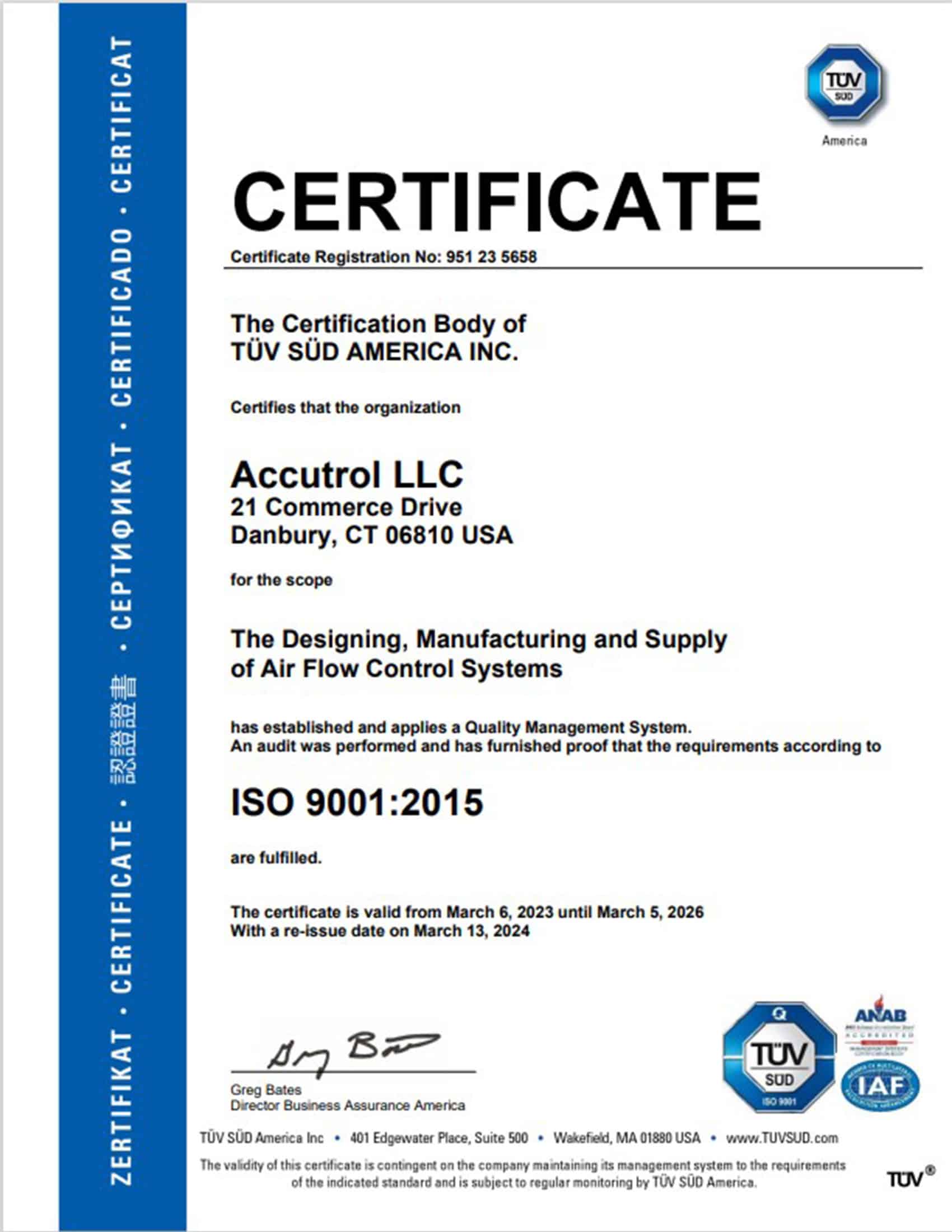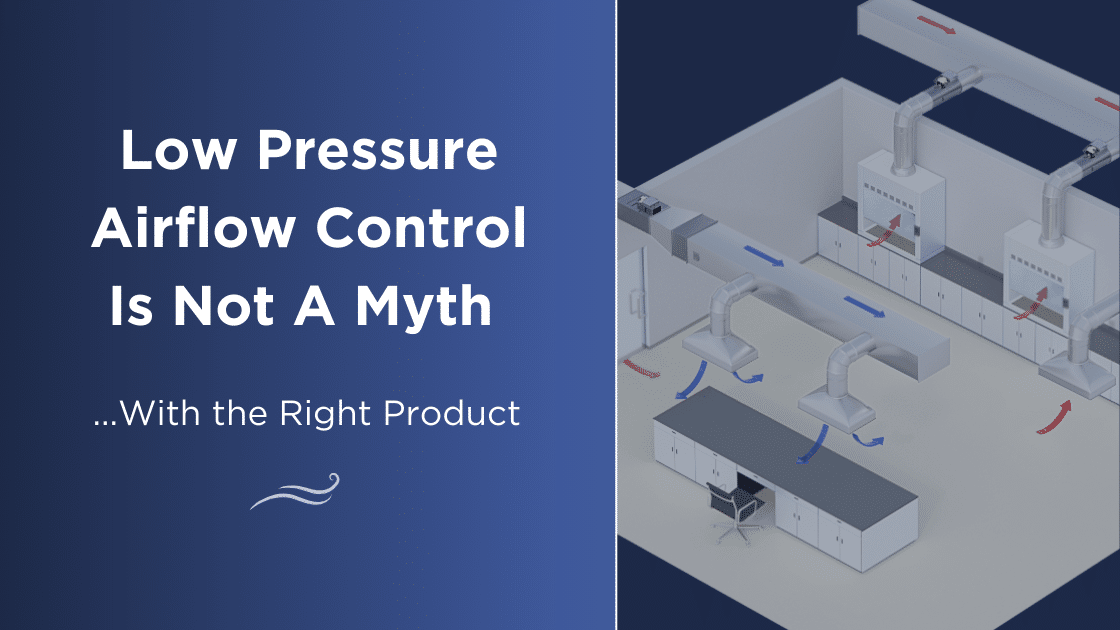

Low Pressure Airflow Control is not a Myth – With the Right Product
Some venturi valve manufacturers have crafted a narrative that may affect your decision for airflow management. This myth implies that high duct pressure is essential for effective airflow control. This is called “the low pressure myth”. If you have been sold a venturi valve, or are considering using venturi valves for airflow management, then you will want to read this article as it will impact your long-term costs and actual airflow measurement.
The low pressure myth is an attempt to convince engineers and building owners that high duct pressure is required to provide safe airflow in critical environments. However, if you investigate the science you’ll find this: the true myth in airflow is the insistence on high pressure itself. It’s not about how much pressure you can exert, but how intelligently you manage the airflow that defines safety and reliability.
For over a decade, a paper steeped in pseudo-science asserts that low duct pressure in critical environments is a recipe for disaster and should be avoided. But here’s the truth that Accutrol has proved over the past 18 years: the myth is just that, a myth. With the right technology, not only is high-speed, stable airflow control possible at low pressure, but it’s also been the choice for award-winning facilities such as Harvard University’s Science and Engineering Complex. They’ve embraced low-pressure solutions, not just for their operational efficiency but for the substantial energy savings they bring to the table. It’s not just about airflow; it’s about smart, sustainable airflow.
Intro: What is The Low-Pressure Myth in Critical Environment Airflow Management?
Venturi valves are part of the old ways of airflow control: mechanical, spring-loaded devices that respond to duct static pressure changes. They’re engineered to manage room pressurization and airflow, especially in the realm of fume hoods, but at a cost: an insatiable hunger for duct pressure, fan horsepower, and inaccurate airflow readings. Since the largest manufacturer of venturi valves for this application only makes mechanical valves, it is not surprising that they would want to convince their customers that this is the only way to safely control airflow. But here’s the kicker: this archaic method bleeds energy and costs 24 hours a day, 7 days per week.
Using modern technological developments over the last several decades, has enabled Accutrol to develop the AccuValve® which offers safe high-speed control at low duct pressures saving users in energy costs.
Why is Low-Pressure Airflow Desirable in Critical Environments?
Energy consumption in critical environments typically runs three times higher than average buildings with 60% of the energy spent directly related to the heating, cooling and air movement. Reducing the energy required to move the air can translate to large savings for building owners. Critical environments may deal with a range of sensitive situations such as immunocompromised patients, chemical research facilities and the study of infectious diseases just to name a few. Thus, two main goals for engineers involved with the design of critical environment facilities are to:
- Create the safest environment possible for workers and patients.
- Manage potential energy costs
Lower pressure airflow devices require less energy, thus resulting in potentially large savings in energy costs.
Related Case Study: University of St. Thomas saves $75,000 annually in energy expenses after replacing their venturi valves with the AccuValve
The Danger of Not Managing Low Pressure Properly
Every day, hundreds of thousands of people work in critical environments daily along with patients in some of these facilities. OSHA’s website claims that 500,000 workers are employed in US laboratories alone. The protection of proper research, isolation of harmful elements, plus worker and patient safety make engineering decisions in critical environments high stakes.
The truth is most traditional airflow devices cannot handle low pressure properly; especially differential pressure-based airflow measurement devices that use single blade airflow control.
Why Mechanical Pressure Independent Valves Such as The Venturi Valve Are Inefficient at Low Pressure
The following points are worth understanding regarding mechanical venturi valves:
- Venturi valves obtain their pressure independence by relying on higher duct pressure.
- Power to obtain this pressure independence is produced using the fan system pressure.
- Thus, fan brake horsepower is used to generate pressure in the duct to make the valves pressure independent.
- The fan system pressure is typically required to be 1.0” to 2.0” higher than what would be required for a system using AccuValves. This is a very inefficient way to obtain pressure independence.
- Because of the mechanical nature of the product, there is no way for venturi manufacturers to circumvent their use of fan energy for pressure independence.
- This drawback to the venturi has led to the unsubstantiated ”Low Pressure Myth” claim.
How is the AccuValve powered?
The AccuValve is powered by a 24 V power supply and pressure independence is achieved through true airflow feedback. No additional fan power required. Closed loop control with airflow measurement is a much more efficient method of developing pressure independence. It is also much safer since airflow feedback is being used for control instead of valve position.
Learn more about AccuValve Airflow Control Valves
What About ASHARE 130 Airflow Standards?
ASHRAE 130, is a critical benchmark for comparing pressure losses between products, but it shouldn’t be the sole factor in design decisions. For example, if a single blade damper is being compared to another product, then looking at the damper’s open state pressure loss overlooks minimum pressure needs. There needs to be a more robust 0.8”-1.0” of minimum pressure, which would put the valve in a range for it to operate reliably.
Similarly, disregarding the ASHRAE 130 standard because a product, like a mechanical venturi valve doesn’t meet it’s the standard risks system efficiency. Venturi valves often specify a broad operating pressure range, such as 0.6” – 3.0” for a valve. They do this to claim pressure independence, but this masks the reality that when used in a system with many valves, the actual minimum operational pressure often exceeds practical design parameters. These parameters often require at least 1.0 to 2.0” of ADDITIONAL pressure. This leads to system inefficiencies, leading to higher energy costs and potential system inadequacies.
A similar issue arises with ASHRAE 90.1. This standard calls for resetting duct pressure by looking at all valve positions in a fan system, and resetting based on the worst-case situation. The mechanical venturi uses the spring and cone assembly to maintain pressure independence instead of valve position. Therefore, there is no way to implement ASHRAE 90.1’s Static Pressure Reset Control as the standard is written. This standard is being used by more and more building owners and can represent large energy savings potential. It’s near impossible to measure properly if the mechanical valves require a high amount of energy and pressure. It’s also unlikely that significant reductions in pressure can be achieved with only some programming added to the BAS as some may claim.
This highlights the importance of considering a variety of factors beyond ASHRAE 90.1 and 130 when designing systems. It’s essential to recognize that effective management of airflow relies on precise measurement, not just metering (monitoring).
The Innovative Accutrol Approach
The AccuValve was the first critical airflow valve design using a “clean sheet” rather than just trying to improve an antiquated design. It is common knowledge today that if you have a critical parameter such as airflow in a critical space that you should measure that parameter and not depend on a mechanical system that may or may not have enough pressure in the system to operate properly.
Key Features and Benefits of The AccuValve:
- It measures airflow continuously; thus, the valve position is not as important as a mechanical valve.
- Our focus is on precise airflow measurement and closed loop control using that airflow measurement. As with any control system you should control using the parameter you want to control.
- AccuValve drives the dual blades to whatever position achieves the desired airflow setpoint not to an arbitrary valve position.
- It achieves the desired airflow using feedback from the airflow measurement and a PID control loop.
- If the fan is not adequate to provide the required airflow, there will be a low flow alarm/notification.
- Taking advantage of physics, the valve is seen to even work with duct pressures as low as 0.1 to 0.2” across the valve.
- The unique compression section and dual blades modulating at different rates make this approach possible. There is no need for specific installation conditions as required with differential pressure sensors and single blade dampers.
- It operates well using high-speed actuators required in critical environments, maintaining stable control over a wide range at very low operating pressures.
- An expected increase in energy savings is common, which comes from reducing the system pressure and using considerably less fan brake horsepower.
- Sound levels are significantly lower, to the point that some people don’t notice them at all.
Conclusion on Low Pressure Airflow in Critical Environments
While saving energy is extremely important in any building, providing a safe system with fast and stable control is the primary objective for any control system. The first step for safety is measuring the parameter that is required. In this case measuring airflow is the critical requirement to ensure a safe environment for the persons in the space being controlled. Measurement of that parameter ensures the maximum safety. Metering does not.
It’s time to move into the 21st century with critical environment airflow controls. Accutrol’s approach gives additional savings and the comfort of knowing that the feedback is of airflow, not valve position. More and more owners are saying yes and moving from mechanical valves to closed loop electronic airflow control valves. Maintaining low-pressure in critical environments is possible with AccuValve, resulting in improved outcomes for those involved with critical environment facilities.
Learn more about AccuValve Airflow Control Valves

